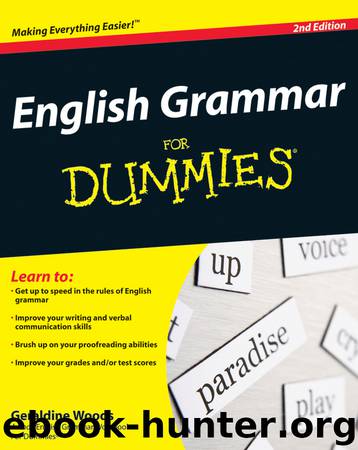English Grammar For Dummies by Geraldine Woods

Author:Geraldine Woods
Language: eng
Format: epub
Publisher: Wiley
Published: 2010-03-09T05:00:00+00:00
Chapter 14
Useful Little Marks: Dashes, Hyphens, and Colons
In This Chapter
Inserting dashes for maximum effect
Using long and short dashes correctly
Placing hyphens in compounds and interrupted words
Knowing where to place a colon in a business letter, list, and quotation
In a classic episode of an old detective show, the hero’s sidekick writes a book. The entire thing has no punctuation whatsoever. The author explains that he’s going to put in “all that stuff” later. Many writers sympathize with the sidekick. Who has time to worry about punctuation when the fire of creativity burns? But the truth is that the three little marks I explain in this chapter — dashes, hyphens, and colons — go a long way toward getting your point across.
Inserting Information with Dashes
Long dashes — what grammarians call “em dashes” — are dramatic. Those long straight lines draw your eye and hold your attention. But long dashes aren’t just show-offs. They insert information into a sentence and introduce lists. Short dashes — technically, “en dashes” — aren’t as showy as their wider cousins, but they’re still useful. Short dashes show a range or connect words when the word to or and is implied.
Long dashes
A long dash’s primary job is to tell the reader that you’ve jumped tracks onto a new (though related) subject, just for a moment. Here are some examples:
After we buy toenail clippers — the dinosaur in that exhibit could use a trim, you know — we’ll stop at the doughnut shop.
Standing on one manicured claw, the dinosaur — delivered to the museum only an hour before the grand opening — is the star of the exhibit.
The information inside the dashes is off-topic. Take it out, and the sentence makes sense. The material inside the dashes relates to the information in the rest of the sentence, but it acts as an interruption to the main point that you’re making.
The words between a pair of dashes may or may not form a complete sentence. Fine. However, some people use only one dash to tack a complete sentence onto another complete sentence. Not fine! (Also, an issue you may encounter on standardized tests.) Here’s what I mean:
WRONG: The curator painted the dinosaur orange — everyone hates the color.
RIGHT: The curator painted the dinosaur orange — everyone hates the color — because she wanted to “liven the place up.”
ALSO RIGHT: The curator painted the dinosaur orange; everyone hates the color.
ALSO RIGHT: The curator painted the dinosaur orange — a color hated by everyone.
The first example sentence is wrong because a dash can’t link two complete sentences. The second example is okay because a pair of dashes can surround a complete sentence embedded inside another complete sentence. The third example avoids the problem by linking the two sentences with a semicolon. The fourth example is correct because a dash may add extra information at the end of a sentence, as long as the extra information isn’t a complete sentence. (A color hated by everyone isn’t a complete sentence.)
Is the
Download
This site does not store any files on its server. We only index and link to content provided by other sites. Please contact the content providers to delete copyright contents if any and email us, we'll remove relevant links or contents immediately.
Cecilia; Or, Memoirs of an Heiress — Volume 1 by Fanny Burney(32503)
Cecilia; Or, Memoirs of an Heiress — Volume 2 by Fanny Burney(31913)
Cecilia; Or, Memoirs of an Heiress — Volume 3 by Fanny Burney(31898)
The Lost Art of Listening by Michael P. Nichols(7456)
Asking the Right Questions: A Guide to Critical Thinking by M. Neil Browne & Stuart M. Keeley(5712)
We Need to Talk by Celeste Headlee(5575)
On Writing A Memoir of the Craft by Stephen King(4893)
Dialogue by Robert McKee(4354)
Pre-Suasion: A Revolutionary Way to Influence and Persuade by Robert Cialdini(4188)
I Have Something to Say: Mastering the Art of Public Speaking in an Age of Disconnection by John Bowe(3861)
Elements of Style 2017 by Richard De A'Morelli(3325)
The Book of Human Emotions by Tiffany Watt Smith(3271)
Fluent Forever: How to Learn Any Language Fast and Never Forget It by Gabriel Wyner(3057)
Name Book, The: Over 10,000 Names--Their Meanings, Origins, and Spiritual Significance by Astoria Dorothy(2961)
Good Humor, Bad Taste: A Sociology of the Joke by Kuipers Giselinde(2924)
Why I Write by George Orwell(2917)
The Art Of Deception by Kevin Mitnick(2770)
The Grammaring Guide to English Grammar with Exercises by Péter Simon(2726)
Ancient Worlds by Michael Scott(2653)
